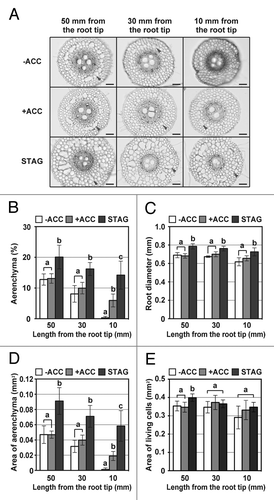Figures & data
Figure 1. Elongation of adventitious roots and viability of adventitious root tips in wheat seedlings. (A) Growth conditions. Eleven-day-old aerobically-grown wheat seedlings were transferred to aerated nutrient solution with or without 20 μM ACC. After 2 d, these seedlings were transferred to stagnant solution and grown for 3 d. While 9-d-old wheat seedlings were transferred to stagnant solution and grown for 7 d. Stagnant solution contained 0.1% (w/v) dissolved agar and was deoxygenated (dissolved oxygen, < 0.5 mgL−1) prior to use by flushing with N2 gas. The broken line with the asterisk indicates when the emergence of the first adventitious roots was observed (day 10). (B) Elongation of adventitious roots during 3 d growth under stagnant conditions (from day 13 to day 16). (C) Cell viability (TTC reduction) in adventitious roots at 0 to 10 mm from the root tips of the wheat seedlings immediately after 3 d growth under stagnant conditions (day 16). The methods are described in more detail by Yamauchi and colleagues.Citation12 Values are means (n = 5) ± SD. Different lower-case letters denote significant differences among the conditions (P < 0.05, one-way ANOVA and then Tukey’s test for multiple comparisons). -ACC; the -ACC seedlings, +ACC ; the +ACC seedlings, STAG; the STAG seedlings, TTC; 2,3,5-Triphenyltetrazolium chloride.

Figure 2. Aerenchyma formation and thickness of adventitious roots in wheat seedlings. (A) Cross-sections. Distances from the root tips are displayed on the top of figures. Lysigenous aerenchyma is indicated by a gray arrowhead. Bar = 100 μm. Cross-sections were prepared by hand-sectioning with a razor blade. Each section was photographed using a light microscope with a CCD camera. The percentages of each cross-section occupied by aerenchyma (B), the diameters of roots (C), the area of aerenchyma (D), and the area of living cells (E) along the adventitious roots of wheat seedlings immediately after 3 d growth under stagnant conditions (day 16). The percentages and area of each cross-section occupied by aerenchyma, and the diameters of the roots in each cross section were determined using ImageJ software (Ver. 1.43u, US National Institutes of Health, Bethesda, MD, USA). The methods are described in more detail by Yamauchi and colleagues.Citation12 Values are means (n = 5) ± SD. Different lower-case letters denote significant differences among the conditions (P < 0.05, one-way ANOVA and then Tukey’s test for multiple comparisons). -ACC; the -ACC seedlings, +ACC ; the +ACC seedlings, STAG; the STAG seedlings.

